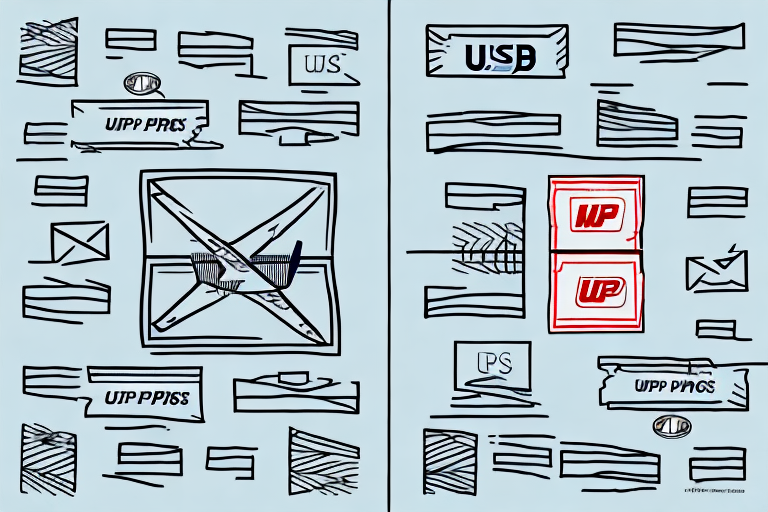Comparing USPS and UPS Shipping Rates: Who Has the Better Deal?
As e-commerce continues to boom, shipping rates have become a crucial consideration for online retailers and consumers alike. USPS and UPS are two of the most popular shipping carriers in the US, offering an array of services for both domestic and international deliveries. But when it comes to comparing their shipping rates, who has the better deal?
Understanding the Basics of USPS and UPS Shipping Rates
Before diving into a comparison of the two carriers, it's important to understand how each calculates its shipping rates. USPS bases its rates on a variety of factors, including package weight, distance of delivery, and service type. UPS, on the other hand, factors in package weight, the value of the goods being shipped, and distance of delivery. Additionally, both carriers offer a range of accompanying services, such as insurance, tracking, and faster delivery options, which also impact the total cost of shipping.
It's worth noting that both USPS and UPS offer discounts for businesses that ship frequently or in large volumes. These discounts can significantly reduce the cost of shipping, making it more affordable for businesses to send packages regularly. However, the specific discounts and requirements for eligibility vary between the two carriers, so it's important to research and compare options before choosing a shipping provider.
Examining USPS and UPS Shipping Rates for Domestic Deliveries
For domestic deliveries, USPS tends to be the more cost-effective option for smaller packages. This is largely due to the fact that USPS offers flat-rate pricing for certain package sizes, regardless of distance. For larger packages or expedited delivery options, UPS can often offer competitive rates. However, it's worth noting that USPS typically has more locations for drop-off and pick-up, making it a more convenient option for many customers.
Another factor to consider when choosing between USPS and UPS for domestic deliveries is the level of insurance coverage offered. USPS automatically includes $100 of insurance coverage for Priority Mail and Priority Mail Express packages, while UPS offers a range of insurance options for an additional fee. Additionally, USPS offers free package tracking for all domestic shipments, while UPS charges for this service unless the package is shipped through their UPS My Choice program.
Analyzing the Cost of USPS and UPS Shipping Rates for International Deliveries
When it comes to international shipping, the rates offered by USPS and UPS can vary significantly depending on a variety of factors, including package weight, destination country, and customs fees. In general, USPS tends to offer more affordable rates for international shipping for packages weighing under 4 lbs. For larger or more valuable packages, UPS may be the better choice, as they offer more comprehensive tracking and insurance options for international shipments.
It's important to note that both USPS and UPS have different delivery times for international shipments. USPS typically takes longer to deliver packages internationally, with delivery times ranging from 6-10 business days for their most affordable shipping option. UPS, on the other hand, offers faster delivery times for international shipments, with their most affordable option typically taking 2-5 business days for delivery. However, faster delivery times often come with a higher price tag, so it's important to weigh the cost and delivery time options when choosing between USPS and UPS for international shipping.
Comparing USPS and UPS Delivery Speed and Reliability
Both carriers offer a range of delivery options, from ground shipping to express overnight delivery. However, UPS tends to have more reliable delivery times for time-sensitive shipments, particularly for larger packages. USPS, on the other hand, can experience delays in delivery times due to issues with sorting and transportation. Additionally, USPS tends to be more reliable for package delivery to rural areas or P.O. boxes.
Another factor to consider when comparing USPS and UPS is the cost of shipping. While both carriers offer competitive pricing, USPS tends to be more affordable for smaller packages and lighter items. UPS, on the other hand, may be a better option for larger and heavier packages, as they offer more cost-effective rates for these types of shipments.
It's also worth noting that both carriers have their own strengths and weaknesses when it comes to international shipping. USPS offers a range of international shipping options, including First Class Mail International and Priority Mail International, which can be a cost-effective option for smaller packages. However, UPS has a larger global network and may be a better choice for larger or more complex international shipments.
Understanding How USPS and UPS Calculate Their Shipping Rates
As mentioned earlier, both carriers calculate shipping rates based on a variety of factors. However, it's worth noting that UPS offers more flexible pricing options for frequent shippers. In particular, UPS's "Volume Pricing" program allows businesses to earn discounted rates based on their shipping volume and frequency. USPS, on the other hand, offers a loyalty program that provides discounts for customers who use their services frequently.
Another factor to consider when comparing USPS and UPS shipping rates is the type of package being shipped. UPS tends to offer more options for larger and heavier packages, while USPS may be a better choice for smaller and lighter packages. Additionally, USPS offers flat-rate shipping options for certain packages, which can be a cost-effective choice for customers who are shipping items that fit within the size and weight restrictions of these boxes.
It's also important to note that both carriers offer additional services that can impact the overall cost of shipping. For example, UPS offers insurance options for packages, while USPS offers delivery confirmation and signature confirmation services. These additional services can provide peace of mind for customers, but they may also come with an added cost.
The Impact of Package Size and Weight on USPS and UPS Shipping Costs
Package size and weight are perhaps the most significant factors impacting shipping rates for both carriers. As previously mentioned, USPS offers flat-rate pricing for certain package sizes, which can be a cost-effective option for smaller shipments. However, UPS offers more flexible pricing options for larger or heavier packages. It's worth noting, however, that oversized or irregularly shaped packages may incur additional charges from both carriers.
Another factor to consider when choosing between USPS and UPS is the distance of the shipment. USPS tends to be more cost-effective for shorter distances, while UPS may offer better rates for longer distances. Additionally, UPS offers a wider range of delivery options, including guaranteed delivery times and weekend delivery, which may be important for time-sensitive shipments.
It's also important to note that both carriers offer additional services, such as insurance and tracking, which can add to the overall cost of shipping. However, these services can provide peace of mind and ensure that your package arrives safely and on time. Ultimately, the best choice between USPS and UPS will depend on your specific shipping needs and budget.
Comparing the Convenience of Using USPS Versus UPS for Shipping Needs
When it comes to convenience, the choice between USPS and UPS largely depends on the specific needs of the shipper. USPS has a significantly larger network of retail locations, which can be a more convenient option for customers who need to drop off or pick up packages. However, UPS offers more comprehensive shipping solutions for businesses, including pickup and delivery services, and more flexible shipping options.
Another factor to consider when comparing USPS and UPS is the cost of shipping. While USPS may be more convenient for some customers, UPS may offer more competitive pricing for certain shipping needs. Additionally, UPS offers a wider range of shipping speeds and delivery options, which can be beneficial for customers who need their packages to arrive quickly or at a specific time.
Understanding the Differences in Tracking Capabilities Between USPS and UPS
Both carriers offer tracking options for shipments, but UPS has a more comprehensive tracking system. In addition to standard tracking information, UPS's system provides real-time updates on the location and status of an individual package, making it a more reliable option for time-sensitive shipments.
However, USPS offers some unique tracking features that may be beneficial for certain types of shipments. For example, USPS offers free tracking for certain types of mail, such as Priority Mail and First-Class Package Service. Additionally, USPS offers a service called Informed Delivery, which allows customers to receive digital previews of their incoming mail and packages.
It's important to consider the specific needs of your shipment when choosing between USPS and UPS. If you require real-time updates and reliable tracking for time-sensitive shipments, UPS may be the better option. However, if you're looking for cost-effective tracking options or unique features like Informed Delivery, USPS may be the way to go.
Examining the Customer Service Experience with USPS Versus UPS
The customer service experience with both carriers can vary significantly depending on the specific situation. For routine shipping needs, both carriers have generally positive reviews for their customer service. However, when issues arise, such as lost or damaged packages, some customers have reported difficulty in resolving the issue with USPS. UPS, on the other hand, has generally been reported to have more responsive customer service.
How to Choose Between USPS and UPS Based on Your Specific Shipping Needs
Ultimately, the choice between USPS and UPS depends on the specific needs of the shipper. For small packages or routine shipping needs, USPS may be the more cost-effective and convenient option. For larger or time-sensitive shipments, UPS may be the better choice, particularly for businesses with more complex shipping needs. It's also worth considering the level of tracking and insurance coverage needed for the specific shipment when making a decision.
Potential Hidden Fees When Using Either USPS or UPS for Shipping
Both carriers have additional fees that can impact the total cost of shipping, beyond just the base shipping rate. For example, USPS charges additional fees for signature confirmation, insurance, and special handling. UPS similarly charges additional fees for special handling, declared value, and delivery to remote areas. It's important to carefully review the terms and pricing for each service before making a decision.
Deciding Which Carrier to Use Based on Overall Value, Not Just Cost
When choosing between USPS and UPS, it's important to consider the overall value of each carrier, beyond just the cost of shipping. This includes factors such as delivery speed, reliability, convenience, and customer service. It may be worth paying slightly more for a carrier that offers more comprehensive solutions and better support for more complex shipping needs.
The Impact of Seasonal Demand on Pricing with Both Carriers
During peak shipping seasons such as holidays, both USPS and UPS may experience pricing fluctuations and longer delivery times. This is particularly true for time-sensitive shipments, which may be subject to longer delivery times or delays. It's important to plan ahead and budget accordingly during these periods.
Final Thoughts: Which Carrier Is Ultimately the Better Deal for Your Specific Needs?
In conclusion, both USPS and UPS offer a range of shipping options for both domestic and international deliveries. Ultimately, the choice between the two carriers depends on the specific needs of the shipper, including package size and weight, delivery speed, reliability, convenience, and customer service. By carefully weighing the pros and cons of each carrier and considering the overall value, shippers can select the carrier that offers the best deal for their specific needs.




















